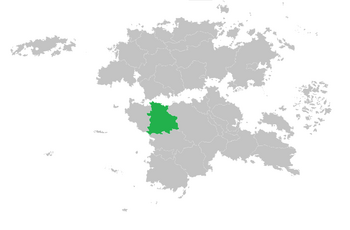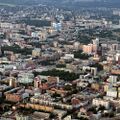Ruvelka: Difference between revisions
(Created page with "{{WIP}} {{Infobox country |native_name = ''Ruvelya Nagyfejedelemség''<br />''Ṷḭṻìłḥi Ṵiųḫûìḥìúìłìṳḻïų'' |conventional_long_name...") |
mNo edit summary |
||
| Line 7: | Line 7: | ||
|national_anthem = <center>"Mi Nem Törik"<br/><small>''We Will Not Break''<br/>[https://www.youtube.com/watch?v=DH8QHWSM4wk&feature=youtu.be Mi Nem Törik (Instrumental)]</small></center> | |national_anthem = <center>"Mi Nem Törik"<br/><small>''We Will Not Break''<br/>[https://www.youtube.com/watch?v=DH8QHWSM4wk&feature=youtu.be Mi Nem Törik (Instrumental)]</small></center> | ||
|image_flag = RuvelkaFlag.png | |image_flag = RuvelkaFlag.png | ||
|image_coat = | |image_coat = CoatOfArmsRuvelka.png | ||
|image_map = RuvelkaTyranMap.png | |image_map = RuvelkaTyranMap.png | ||
|map_caption = Ruvelka’s location on the continent of Inara in Tyran. | |map_caption = Ruvelka’s location on the continent of Inara in Tyran. | ||
Revision as of 20:32, 28 February 2019
This article is incomplete because it is pending further input from participants, or it is a work-in-progress by one author. Please comment on this article's talk page to share your input, comments and questions. Note: To contribute to this article, you may need to seek help from the author(s) of this page. |
Grand Principality of Ruvelka Ruvelya Nagyfejedelemség Ṷḭṻìłḥi Ṵiųḫûìḥìúìłìṳḻïų | |
|---|---|
| Motto: Ruvelkan Script: İṷıűűï Łīḥíłĩḻ "Forever Loyal." | |
| Anthem: We Will Not Break Mi Nem Törik (Instrumental) | |
 Ruvelka’s location on the continent of Inara in Tyran. | |
| Capital and largest city | Debrecen |
| Official languages | English, Ruvelkan |
| Recognised regional languages | Hayeren, Karvelebi |
| Ethnic groups | 85.7% Ruvelkan 6.3% Hayer 5.2% Karvelebi 2.8% Other |
| Demonym(s) | Ruvelkan |
| Government | Federal Parliamentary Elective Monarchy |
| Elsa Szekeres | |
| Monika Prohászka | |
| Legislature | Federal Assembly |
| District Assembly | |
| People's Assembly | |
| Formation | |
• Confederation | 11 February 1701 |
• Ruvelkan Imperium | 10 November 1730 |
• Socialist Republic | 5 March 1865 |
• Principality | 13 September 1918 |
• Grand Principality | 11 February 1938 |
| Population | |
• 2017 census | 177,432,650 |
| Gini (2017) | low |
| HDI (2017) | very high |
| Currency | Lari (Ł) (LRI) |
| Date format | mm-dd-yyyy |
| Driving side | right |
| Internet TLD | .ruv |
Ruvelka, officially known as the Grand Principality of Ruvelka (/ruːvɛlkɑː/; Ruvelkan: Ruvelya Nagyfejedelemség; Ruvelkan Script: Ṷḭṻìłḥi Ṵiųḫûìḥìúìłìṳḻïų), is a sovereign state located on the western side of the continent of Siduri in Tyran. It is bordered by Syara to the west, Allamunnika to the east, and Mansuriyyah to the south with coastlines along the Sundering Sea and the Nuandan Ocean. The nation is geographically divided by a combination of the Matra and Kurilla mountain ranges that effectively split the nation in western and eastern halves; this resulted in the creation of two distinct cultures that share a common heritage.
The territory of modern Ruvelka was, for several centuries, inhabited by a succession of peoples that included Makedonians, Galanians, Kydonians, Allamunniks, Arkoennites, and members of the Syaran Clans. The foundations of a Ruvelkan state began with the establishment of the Union of Kurillan Matriarchs in the tenth century which formed an alliance between six of the most powerful city-states along the eastern half of the Kurilla mountains. The Union lasted for several centuries before their eventual conquest by the Arkoennite Empire.
Ruvelkans would once again gain their independence in the late 1700s and the first overtures of a united Ruvelkan state culminated in the creation of the Ruvelkan Confederation. The power of the various noble houses was eventually consolidated under the rule of Princess Kíra Prohászka which resulted in the creation of the Ruvelkan Imperium in 1730. The Red War that took place in the 1860s eventually usurped the monarchy and led to the establishment of the Ruvelkan Socialist Republic, which was in turn overthrown in a second conflict.
Ruvelka is often considered a middle power in the region, possessing a substantial industrial sector, a well developed market, and home to rich mineral deposits. The nation’s recent victory over Syara during the Zemplen War has also secured its reputation as a capable military power.
History
Ruvelkan Confederation
The Ruvelkan Confederation was declared in 1701 following the collapse of the Arkoennite Empire and the subsequent independence of the Ruvelkans from Akroennite rule. Created as a result of the Derecske Congress, it was an association of 42 Ruvelkan-speaking states in northwest Siduri and was initiated as an attempt to create a singular Ruvelkan state. Most historians contend that the Ruvelkan Confederation was relatively ineffective with political infighting and rivalries between cities undermining its objectives.
Kíra Prohászka, the ruling Royal Princess of the city of Debrecen, began advocating for the creation of an elective monarchy in 1728 and garnered significant support among kingdoms in central and eastern Ruvelka—areas in which the Prohászkas historically possessed significant support. However, the western nations were generally opposed to the notion of a singular ruler and voted against the move for a monarch in the time period between 1728 and 1729.
By March 1730, Ruvelka was split between two power blocks consisting of those for and against the elective monarchy. Tensions between the two factions escalated into a brief armed conflict that last several weeks before ending in an agreement that would lead to the creation of a unified Ruvelka under the authority of an elected monarch. In November 1730, the Declaration of Derecske was agreed upon by the majority of the ruling families of Ruvelka. Kíra was elected to be the new nation’s first monarch, taking on the title “Matriarch Queen”.
Ruvelkan Imperium
Red War
Dissatisfaction with the ruling nobility, primarily those within the Imperial Parliament, alongside the lack of action against Syaran aggression eventually led to the outbreak of the Red War. Inspired by liberal and radical ideas, a Communist faction made up primarily of common folk and led by András Váradi spearheaded a revolution that profoundly altered the course of Ruvelkan history. The foundation of the common people’s Red Army overwhelmed the pro-Imperial Whites in a conflict that lasted three years.
A relatively honorable conflict, the Red War has been commonly called a gentlemen's’ dispute. Civilians were never targeted and most battles were pitched battles on open ground between organized armies. The war ended with the surrender of Imperial general Pyotr Dorman and lead to the establishment of the Ruvelkan Socialist Republic.
In the modern-era, the Red War is often romanticized in popular culture, focusing on the honorable elements of the war and many of the larger-than-life leaders of both sides.
Ruvelkan Socialist Republic
Ruvelkan Civil War
The civil war broke out in December of 1914 between the pro-Communist regime and the anti-authoritarian Imperial Separatists. Aside from the two main factions of the war, a multitude of other smaller and independent factions also rose up and fought against the Communists and the Imperials. The Ruvelkans were primarily left to the own devices during the civil war, with the Imperials receiving some financial assistance from the nearby Cacertian Empire and Syara’s intervention that led to the annexation of the Zemplen region.
The conflict resulted in widespread damage throughout the whole nation. Both the Communists and the Imperials conducted campaigns of total war that left Ruvelka’s formerly extensive industrial economy and infrastructure in shambles. Famines and epidemics became relatively common during the war as it became difficult to transport food and medicine throughout the country. The loss of life as a result of the conflict is often considered the worst national catastrophe ever to occur on the continent with total casualties reaching nearly seven million dead.
The defeat of the Communists in 1918 led to the restoration of the elective monarchy and the creation of a federal, multi-party, socialist state.
Principality and the Siduri War
Following the end of the civil war, the first major objective of the new government was to rebuild and reconstruct Ruvelka’s devastated infrastructure. A new network of national roads was gradually built up and Aszód and Mátészalka were reopened to Nuandan Ocean and Sundering Sea trade respectively. The new Principality worked tirelessly in order to receive official recognition by nations throughout the region which, for the most part, it did successfully with an open foreign policy. The new influx of imports and with a market for the nation’s raw materials, Ruvelka began to experience an economic boom from which several of the Imperialist social programs began to spring up.
The question of the fate of the Zemplen region still loomed over Ruvelkans even though it had been agreed upon to cede the territory to Syara in the midst of the civil war. Regaining the territory was not a major component of the new government’s agenda, but tensions between Syara and Ruvelka remained high. The recent Syaran victory in the Divide War against the perceived technologically superior Cacertian Empire catalyzed a remilitarization program for fear of future Syaran aggression. Large amounts of government funding went to training the new army and purchasing arms and materiel from abroad.
This fear proved correct when Syara invaded Ruvelka in April 1934. What Ruvelkans did not expect, however, was an invasion from the east coming from Allamunnika which caught much of Ruvelka’s eastern army by surprise. Ruvelka, despite stiff resistance on both fronts, was conquered by August the same year; the government did manage to evacuate to the Cacertian Empire before the capitulation of Debrecen.
A wartime resistance movement, organized into what became known simply as the Földalatti, fought against both Syaran and Allamunnik occupation and remained loyal to the Ruvelkan government-in-exile. Prior to the war, the Ruvelkan Cipher Division developed a number of sophisticated ciphers and this technology allowed the Földalatti to remain in consistent contact with government leaders in Cacerta.The Ruvelkan Csúcs codes were famously never broken during the conflict and provided critical intelligence on military movement within the nation.
Post-War Era and Present Day
Geography
Landscape
Ruvelka encompasses a large diversity of landscapes throughout its large area which include its snow-capped mountains, thick pine forests, and grassy steppes. The most important geographic features of Ruvelka are the Kurilla and Matra mountain ranges. the Kurilla mountains are located centrally within Ruvelka and stretch from north to south, separating the nation into east and west. The Matra follow east to west along Ruvelka’s border with Mansuriyyah.
53 of Ruvelka’s mountains reach about 4,000 meters above sea level. At 4,823 meters, Kiskun—located in Derecske District—is the highest mountain within Ruvelka and is located within the Kurilla mountain range.
Within the high valleys of Ruvelka’s mountains, there are dozens of glaciers from which the headwaters of several major rivers (such as the Berounka, Vitlava, and Hornad) originate. The hydrographic network within Ruvelka include several large bodies of freshwater and consists of over 400,000 lakes. Approximately 9% of Ruvelka’s national territory consists of freshwater lakes and glaciers.
Large portions of the land, particular the area close the foothills of the mountain ranges, consists of coniferous forests and fens. Approximately 68% of Ruvelka consists of forests primarily made up of pine, spruce, and birch trees; as a result of this, Ruvelka is one of the largest producers of wood within Siduri.
Climate
Ruvelka possesses a temperate oceanic climate with warm summers and cold, cloudy, and snowy winters. The temperature difference, especially within the central parts of the nation, is relatively high.
Temperatures vary greatly depending on the elevation of the location. Areas at higher altitudes generally see their temperatures decrease and precipitation increase; some of the wettest areas in Ruvelka are found in the Kurilla Mountains whereas the driest region is in the plains South of the Matra Mountains. At the highest peak of Kiskun the average temperature is −0.5 °C.
The coldest month is usually January followed by December and then February. During these months, snow is common throughout the major cities and a large portion of the lowlands. Temperatures generally increase during the months of March, April, and May and weather tends to vary greatly. High water levels usually occur during the spring as a result of melting snow flowing down from the mountains. The warmest months are July, August, and June with most rainfall occurring in the summer; thunderstorms are very common during the summer season.
Demographics
Peoples
The Ruvelkans are an ethnic group native to north-central Siduri and native to the geographical location of present-day Ruvelka. They share a common ancestry, culture, history, and are native speakers of the Ruvelkan language and its various dialects. The formation of the Ruvelkan identity is often traced back to the time period following in the end of the Makedonian Empire and resulted in several independent kingdoms. Eventually conquered by the Arkoennites, the Ruvelkans lived in relative peace.
The collapse of the Arkoennite Empire brought about the Ruvelkan Confederation which later incorporated other north-central and north-western Sidurian ethnic groups, primarily Hayers and Karvelebi; both developed distinctive cultures and co-existed well with Ruvelkans.
Today, Ruvelkan is primarily inhabited by ethnic Ruvelkans. In the 2017 Census, 85.7% reported Ruvelkan as their first identity, 6.3% Hayer, 5.2% Karvelebi, with the final 2.8% consisting of various other ethnicities from the region.
Population Centers
Ruvelka’s primary population centers are built around major resource centers originally founded early in the time long before the Confederation. Prior to the creation of Ruvelka’s national rail system in the 19th century, many of these cities had large and concentrated populations. The Ruvelkan population began to spread to smaller cities early in the 1800s during the latter years of Ruvelkan Imperium.
Largest cities or towns in Ruvelka
Department of Logistics and Population Control | |||||||||
|---|---|---|---|---|---|---|---|---|---|
| Rank | Region | Pop. | |||||||
 Debrecen  Székesfehérvár |
1 | Debrecen | Debrecen District | 8,645,002 |  Derecske  Aszód | ||||
| 2 | Székesfehérvár | Székesfehérvár District | 6,844,620 | ||||||
| 3 | Derecske | Derecske District | 2,340,650 | ||||||
| 4 | Aszód | Aszód District | 2,204,231 | ||||||
| 5 | Zalaegerszeg | Zalaegerszeg District | 1,188,664 | ||||||
| 6 | Püspökladány | Püspökladány District | 1,183,402 | ||||||
| 7 | Mátészalka | Mátészalka District | 1,180,332 | ||||||
| 8 | Hajdúböszörmény | Debrecen District | 1,180,287 | ||||||
| 9 | Balatonalmádi | Balatonalmádi District | 1,179,359 | ||||||
| 10 | Nagykanizsa | Derecske District | 1,78,896 | ||||||
Languages
Ruvelkan is the primary spoken language in Ruvelka and is the native language of the Ruvelkans. It is also the official language of the nation alongside English. The written standard is the Ruvelkan alphabet which consists of 44 characters; a latin based transliteration of the language was developed in the 1950s to assist foreigners in understanding written Ruvelkan.
English is commonly learned and studied as a second language. As of 2016, more than 60% of Ruvelkans declared to speak English. Syaran came second and German was third; other commonly spoken foreign languages include Italian, French, and Allamunnik.
Hayeren and Karvelebi are regionally recognized minority languages which are guaranteed certain rights such as education in that language and having said language established as a secondary administrative language for regions where it is commonly spoken.
Religion
| Affiliation | % of Ruvelkan Population | |
|---|---|---|
| Vilageism | 88 | |
| Arordi | 4.1 | |
| Native Karvelebi | 3.2 | |
| Other Religions | 2.1 | |
| Unaffiliated | 2.6 | |
The modern Grand Principality has no official state religion and religious tolerance has been an important part of the nation’s political culture ever since the Imperial period. Freedom of religion was officially guaranteed when the new Ruvelkan Constitution, developed by the Imperial Separatists, was ratified after the end of the civil war in 1918.
Ruvelka is the birthplace and home of Vilageism, a religion that places a special emphasis on astrological and cosmological movements. Cosmological signs regulate the important dates of the Vilageian religious calendar. The most important events in Vilageism include the solstices, equinoxes, and both solar and lunar eclipses. It is unique in that it does not possess any deities and does not practice worship in a traditional sense although temples have been built in the name of the Vilageian faith.
In 2015, an estimated 88% of the population belonged to the Vilageian faith. Other contemporary religious minorities include members of the native Hayeren Arordi faith and the Native Karvelebi Faith. There are also smaller numbers of Azurlavaian pagans, followers of the Syaran Zobethos, Concordians, and Cacertian Monotheists.
Government
Federal Assembly
Monarchy
Foreign Relations
Armed Forces
The current form of the Imperial Armed Forces of Ruvelka were officially founded in September 1918 following the end of the Ruvelkan Civil War and the formalization of the Separatist Volunteer Guard. Ruvelka's Military consists of five major branches: the Imperial Army, Imperial Air Force, Imperial Navy, Imperial Fusiliers and the Territorial Defense Force—founded in 1938 after the end of the Siduri War. They are controlled by the Principality's Ministry of Military Affairs and report to the Minister of Defense, although the commander-in-chief is the currently elected Monarch.
The primary mission of Ruvelka’s armed forces is the defense of Ruvelkan territorial integrity and any Ruvelkan interests abroad. Ruvelkan military doctrine is defensive in nature, employing the use of the nation’s heavily mountainous and forested terrain to wear down an aggressor instead of attempting to hold an attacking army in a traditional battleline.
Service in the armed forces is mandatory, implemented in 1938 after the Siduri War, and requires any man or woman above the age of 18 to serve one to two years of armed service, or three years of civilian service. Ruvelka’s military consists of a cadre of professional soldiers, those serving their mandatory military service obligation, and a large reserve with a standard readiness strength of approximately 887,000 in uniform. Women have been allowed to serve in all combat arms, including front-line infantry and special forces, since 1918.
Ruvelka’s historically tumultuous relationship with neighboring Syara eventually culminated in the Zemplen War, effectively the first major conflict fought by Ruvelkans since the Siduri War, where Ruvelka’s doctrine of defense-in-depth proved effective.
Economy
Ruvelka has a mixed economy, whose characteristics include state ownership of key sectors, regulated markets for private enterprise, and an extensive welfare state. It possesses a combination of free market activity and large state ownership in certain key sectors. Public health care in Ruvelka is free and parents have forty weeks of guaranteed paid parental leave. The unemployment rate in 2016 was 8.7%, having dropped from 9.8% in 2013; youth employment rose from 15.2% in 2006 to 20.2% in 2016. 68% of the Ruvelkan population between the ages of 16–75 are employed with approximately 28% of the labor force employed by the government. The egalitarian values of Ruvelkan society, stemming back to the late 1700s and put into action after the Red War, have kept the wage difference between workers and CEOs significantly lower than in other countries.
Ruvelka possesses significant timber, mineral, and freshwater resources. Forestry, mining, and the agricultural sector are particularly important for rural residents. The two largest export industries of Ruvelka are the metal and forest industries, both of which saw significant amounts of industrialization after the end of the Siduri War. The metal industry focuses on metal working, engineered products, and refined metals (such as steel, copper, and chromium). The forest industry includes forestry, timber, and the production of pulp and paper ( approximately 71% of Ruvelka is forested, much of it in renewable use). Ruvelka’s large forest industry makes it a prominent member in inter-Siduri economics.
The diversification of the Ruvelkan economy has also led to the development of industries in electronics, chemicals, and information technology.
Tourism
In 2014, the Ruvelkan tourism industry saw a 6% increase from its previous year. This growth is attributed to globalization along with a rise in positive publicity and regional awareness. The Ruvelkan landscape is often considered relatively virgin, consisting of thick forests, rolling hills, and snow-capped mountains. A number of government policies is constantly being enacted in order to preserve the nation’s natural beauty; as a result Ruvelka has approximately 63 national parks throughout the nation.
River and lake cruises, skiing, fishing, hiking, and kayaking are among some of the most popular outdoor activities in Ruvelka. Wildlife is also significantly abundant in Ruvelka and both hunting and bird-watching are also very popular. The nation’s cities and urbanized regions also possess many cultural events and activities.
Infrastructure
Transportation
Transportation in Ruvelka is largely achieved by rail, road, and air. A large and extensive rail-system, which began construction in early 1800s, extends throughout the country and is often listed as the standard form of travel for the nations citizens. Cities that are not connected by train are accessible by direct flight from city to city.
Energy
The electricity generation sector in Ruvelka is still largely fossil-fuel based with a significant portion generated via nuclear energy. Recent administrations have begun to fund and pursue renewable sources of energy and hope to have 25% of the nations electricity generated by renewable energy sources by 2022; this is planned to be primarily achieved by wind farms and hydroelectric stations.
Education
Culture
The unique character of Ruvelka’s culture is closely tied to its many centuries long history. Over time, it received significantly influences from neighboring Syara, Allmunnika, and Mansuriyyah. The assertion of a unique Ruvelkan culture, however, did not begin to gain significant ground until after the fall of the Akroennite Empire in the 1700s. Since then, and despite generally appearing as a terse people, Ruvelkans have traditionally been seen as hospitable to various artists.
Cuisine
Ruvelkan cuisine is eclectic and has evolved over several centuries, sharing similarities with other northwestern Sidurian cultures. Ruvelkan cuisine makes common use of meats, poultry, honey, potatoes, and various other root vegetables. Rye, wheat, barley, and millet serve as ingredients for various breads, pancakes, and cereals. Ruvelkan meals are generally considered to be very hearty and make heavy use of cream and eggs. Beer and vodka are popular drinks within Ruvelka which also has a lengthy tradition of brewing.


